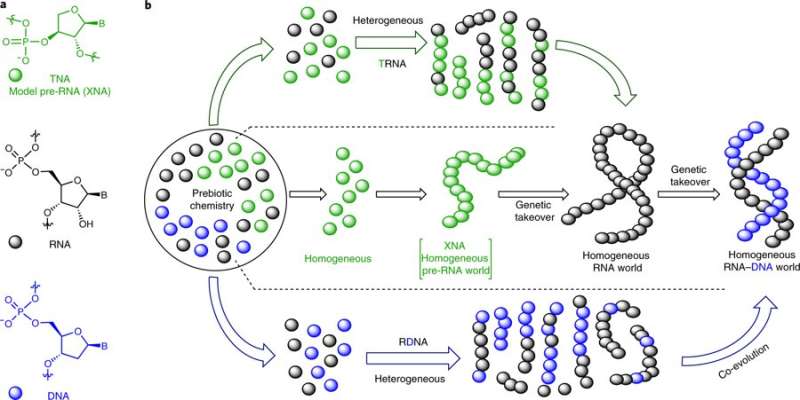September 17, 2019 report
Researchers suggest RNA and DNA got their start from RNA-DNA chimeras

A pair of researchers with the Scripps Research Institute has suggested that RNA and DNA got their start billions of years ago from RNA-DNA chimeras that contained RNA and DNA building blocks. In their paper published in the journal Nature Chemistry, Subhendu Bhowmik and Ramanarayanan Krishnamurthy outline their theory and argue that it makes more sense than the traditional explanation for how life got its start on Earth.
For many years, the consensus among scientists looking to understand the origins of life has been that a pre-RNA precursor with building blocks arose in the prebiotic soup. After that, the building blocks somehow formed into pre-RNA and eventually into actual RNA. Once that happened, there was a transition to both RNA and DNA. One major stumbling block to proving that such a scenario led to the development of life has been the inability to explain how RNA could replicate itself in a sustainable way. In this new effort, Bhowmik and Krishnamurthy suggest it did not have to, because RNA and DNA came about in a different way. In their view, the building blocks of RNA and DNA were both in the prebiotic soup. Over time, those building blocks formed into double-stranded chimeric RNA-DNA strands. And over more time, those chimeras transitioned into pure RNA and DNA.
To bolster their theory, the researchers note that prior studies have shown that hybrid molecules made of RNA and DNA building blocks were less stable than either RNA or DNA—some believe this demonstrates why RNA and then DNA became the basis for life. Bhowmik and Krishnamurthy disagreed, suggesting instead that the weaker hybrid molecules would make it easier for nature to transition to pure RNA and DNA. This meant the molecules were not subject to the replication problem with pure RNA. Testing in the lab showed that when RNA-DNA chimeras replicate, they preferentially form into separate RNA and DNA molecules, rather than new chimeras. They acknowledge that no known living creature has any sort of chimeric RNA-DNA in its genome—but they also point out that other researchers have been able to force it into an E. coli genome. And some other microorganisms make them seemingly by accident—but then very quickly eliminate them.
More information: Subhendu Bhowmik et al. The role of sugar-backbone heterogeneity and chimeras in the simultaneous emergence of RNA and DNA, Nature Chemistry (2019). DOI: 10.1038/s41557-019-0322-x
Journal information: Nature Chemistry
© 2019 Science X Network





















